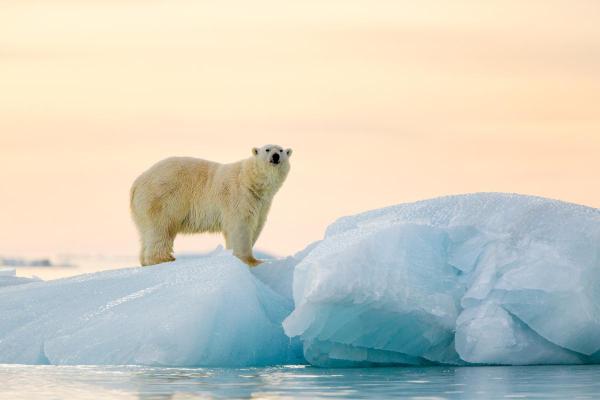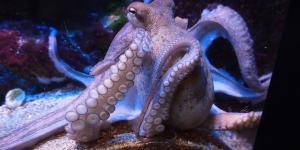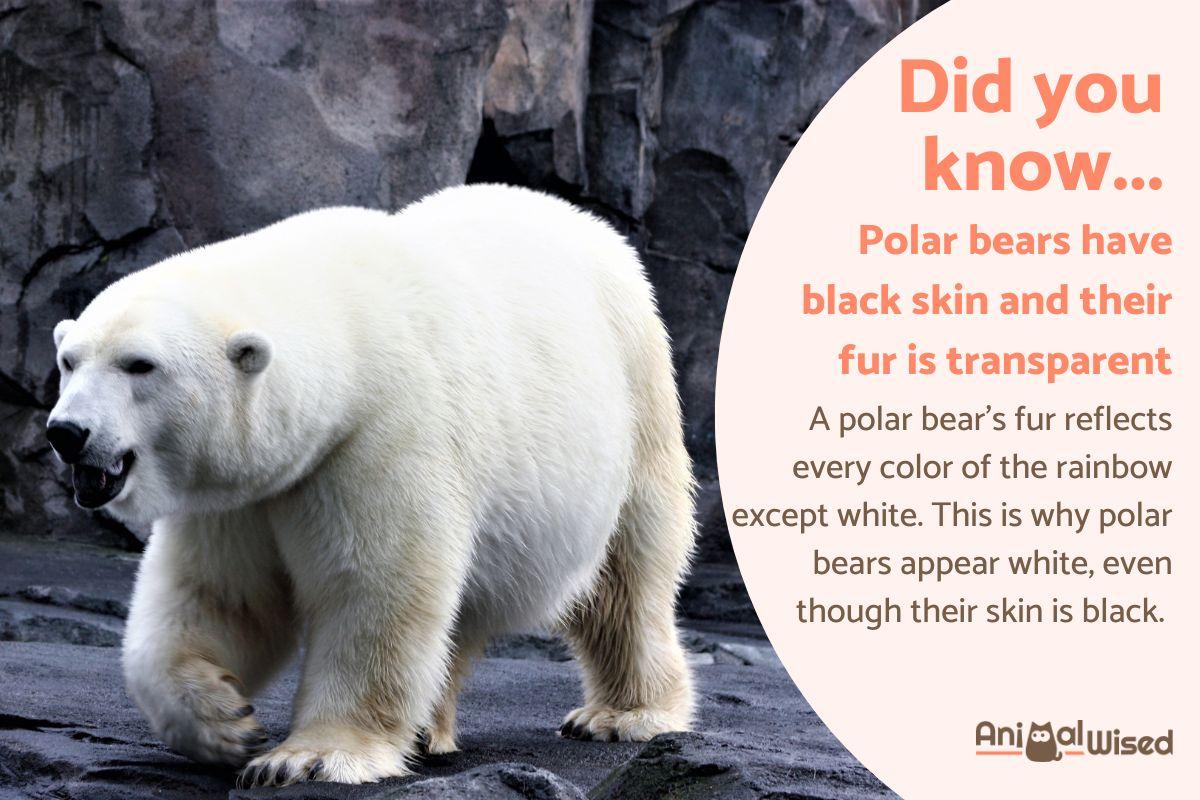20 Amazing Facts About Polar Bears


Mysterious giants roaming the icy plains, polar bears, the world's largest land predators, reign supreme in the Arctic. Sadly, these impressive animals face an unsure future because of climate change. Understanding their fascinating lives and special abilities is vital, not only to protect them, but also to keep our planet's ecosystems in balance.
In this article AnimalWised article, we will explore 20 amazing facts about polar bears, their remarkable adaptations, and the challenges they face in a changing world.
- They hold the title of largest terrestrial carnivore.
- They boast naturally black skin
- They excel as swimmers
- They exhibit the lowest reproduction rate among mammals
- They experience induced ovulation
- They experience delayed implantation after fertilization
- They endure the longest periods without food
- They possess specialized teeth
- They display pronounced sexual dimorphism
- They share a close evolutionary relationship with brown bears
- Other amazing facts about polar bears
They hold the title of largest terrestrial carnivore.
Polar bears, the apex predators of the Arctic, are obligate carnivores, relying almost exclusively on meat for survival. Their primary prey are ringed seals, which they hunt from atop sea ice. However, they are opportunistic feeders and will also take other seals, walruses, beluga whales, and even scavenge on carcasses when available.
Despite their immense size, reaching up to 800 kg (1,760 lbs) for males, and their high metabolism requiring up to 30 kg (66 lbs) of food daily, plant matter like berries and seaweed plays an insignificant role in their diet.
Hungry for more? Explore the unique dietary habits of polar bears in our other article.
They boast naturally black skin
While polar bears appear white due to their fur, their skin is actually black. This seemingly contradictory combination serves two crucial purposes, camouflage and heat absorption.
The hollow, transparent hairs of their fur act like tiny glass fibers, scattering sunlight and creating the illusion of whiteness, allowing them to blend seamlessly into their snowy environment while hunting prey. Furthermore, their black skin beneath the fur absorbs sunlight efficiently, helping them stay warm in the frigid Arctic temperatures.
This adaptation, combining camouflage and heat absorption, is a key aspect of their survival in the harsh Arctic environment.
They excel as swimmers
Polar bears are not only formidable hunters but also exceptional swimmers. Their hollow, air-filled fur acts like a life jacket, aiding buoyancy, while their large, powerful front legs function like oars, propelling them through the water. For added maneuverability, their smaller hind legs act as rudders, allowing them to steer and dive.
This skillful combination enables them to fully submerge for up to 3 minutes and navigate vast distances in the Arctic seas. In fact, some polar bears have been documented swimming continuously for up to 100 kilometers (62 miles) at speeds reaching 6 miles per hour (10 kilometers per hour).
This impressive swimming ability is further enhanced by their thick layer of blubber, which not only insulates them in the frigid water but also provides additional buoyancy. These adaptations are crucial for polar bears, allowing them to hunt seals across scattered sea ice and navigate open water in search of new hunting grounds, especially with shrinking sea ice due to climate change.

They exhibit the lowest reproduction rate among mammals
Polar bears exhibit K-selection traits, characterized by late sexual maturity, small litters of typically two cubs (though ranging from one to four), and high parental investment.
This means females invest a significant amount of time and energy into raising their cubs, contributing to a relatively low cub mortality rate, ranging from 10 to 30%. Adults, on the other hand, benefit from a high survival rate, thanks to their formidable size and hunting prowess.

They experience induced ovulation
Female polar bears have a unique reproductive process adapted to their harsh Arctic environment. They experience a prolonged estrous cycle lasting from late March to early June.
Unlike many other mammals, they are induced ovulators. This means ovulation only occurs after they have mated with a male. This adaptation helps ensure that cubs are born at the optimal time for survival.
They experience delayed implantation after fertilization
Polar bears have a unique reproductive pattern. While their mating season peaks between April and May, a fertilized egg doesn't implant in the uterus until fall. This delay, known as delayed implantation, ensures that cubs are born during favorable conditions with abundant resources. By timing births to coincide with the arrival of harsh weather and prime hunting opportunities, polar bear mothers maximize the chances of their cubs' survival.
This adaptation is influenced by environmental factors and the female's body condition. Due to delayed implantation, the total gestation period can range from 195 to 265 days. Once implantation occurs, the active pregnancy lasts approximately two months.
They endure the longest periods without food
Pregnant female polar bears enter a state of torpor in their dens from approximately September/October to late March/early April. This is when they give birth and nurse their cubs.
During this time, they do not eat and rely solely on their fat reserves. While their activity levels and metabolism are reduced, this state differs from true hibernation as their body temperature does not decrease significantly, unlike other hibernating animals.
Uncover the amazing ways polar bears stay warm in the frigid Arctic in this other article.

They possess specialized teeth
Polar bears are not only the largest land-based carnivores, but also possess specialized teeth perfectly adapted for their icy hunting grounds. Unlike many carnivores with sharp, pointed teeth designed for tearing flesh, polar bears have blunt, powerful molars and premolars. These blunt teeth function like powerful ice picks and crushing tools, allowing them to efficiently break through the blubber and bones of their prey, primarily seals. Additionally, their ridged canine teeth are well-suited for gripping and holding onto slippery prey in the water.
Furthermore, polar bears have exceptionally strong jaws, providing the necessary force to bite through tough hides and bones. Interestingly, despite their meat-heavy diet, polar bears still retain four small incisors in their upper jaw, although their function is not fully understood by scientists and may be vestigial (remnants of ancestral characteristics).
They display pronounced sexual dimorphism
Polar bears exhibit significant sexual dimorphism, meaning males are considerably larger and heavier than females. This difference is evident in both size and weight.
Males typically weigh between 300 and 800 kg (660 to 1,760 pounds) and can reach up to 2.5 meters (8.2 feet) in length, while females generally weigh 150 to 300 kg (330 to 660 pounds) and measure 1.8 to 2 meters (5.9 to 6.6 feet) long. This size difference is thought to be related to their hunting strategies, with males needing more energy to hunt larger prey like walruses.

They share a close evolutionary relationship with brown bears
Previously thought to be descendants of brown bears, polar bears are now recognized as sister lineages. This means they share a common ancestor that lived over a million years ago, but they evolved independently as separate species.
Interestingly, some interbreeding between polar bears and brown bears has occurred, leading to some genetic exchange between these closely related species.

Other amazing facts about polar bears
As we have seen, polar bears are captivating creatures with unique adaptations that allow them to survive in such a harsh environment. Let us take a closer look at 10 other fascinating facts that will make you appreciate these Arctic giants even more:
- Polar bears boast an exceptional sense of smell, capable of detecting prey from considerable distances.
- They rely on a thick layer of fat, measuring up to 3.9 inches (10cm), under their skin for insulation.
- They are equipped with large, powerful paws with non-retractable claws that aid in traversing icy terrain and gripping onto prey.
- Despite their size, polar bears are remarkably agile and can run at speeds of up to 40 kilometers per hour (25 miles per hour) on land.
- Their specialized kidneys efficiently filter sea salt, enabling them to drink seawater when necessary.
- While swimming, polar bears can keep their eyes above the water surface, and their excellent night vision aids in their nocturnal activities.
- Their liver has a specialized adaptation that allows them to process large quantities of vitamin A obtained from consuming the liver of their prey.
- Despite their solitary nature, polar bears are known to exhibit some social behaviors, including interactions during mating, maternal care, and occasionally congregating at food-rich areas such as seal haul-out sites.
- Polar bears face significant threats from climate change and habitat loss, underscoring the urgent need for environmental conservation efforts in the Arctic.
- Polar bears play a crucial role in maintaining the health of Arctic marine ecosystems by regulating prey populations, ensuring the balance of the food web in their habitat.
Curious about other creatures of the Arctic? Discover them all in our detailed guide.
If you want to read similar articles to 20 Amazing Facts About Polar Bears, we recommend you visit our Facts about the animal kingdom category.
- Gunderson, A. (2009). " Ursus maritimus ." Animal Diversity Web. Available at: https://animaldiversity.org/accounts/Ursus_maritimus/
- Lan, T., Leppälä, K., Tomlin, C., Talbot, SL, Sage, GK, Farley, SD, Shideler, RT, Bachmann, L., Wiig, Ø., Albert, VA, Salojärvi, J., Mailund, T., Drautz-Moses, DI, Schuster, SC, Herrera-Estrella, L., & Lindqvist, C. (2022). Insights into bear evolution from a Pleistocene polar bear genome. Proceedings of the National Academy of Sciences of the United States of America , 119 (24), e2200016119. https://doi.org/10.1073/pnas.2200016119
- Wiig, Ø., Amstrup, S., Atwood, T., Laidre, K., Lunn, N., Obbard, M., Regehr, E., and Thiemann, G. (2015). Ursus maritimus . IUCN Red List of Threatened Species 2015. Available: https://dx.doi.org/10.2305/IUCN.UK.2015-4.RLTS.T22823A14871490.en










